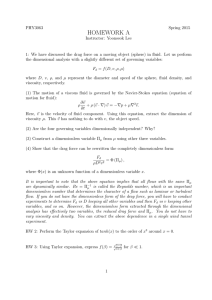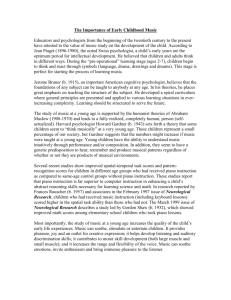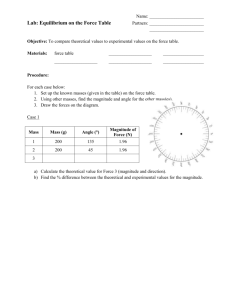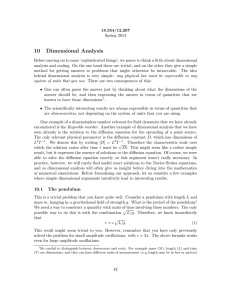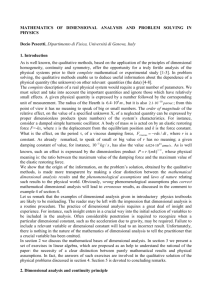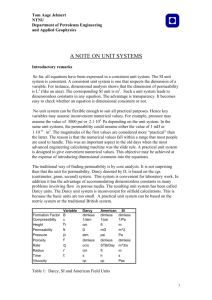ES265 Order of Magnitude Phys & Chem Lecture Outline 1
advertisement
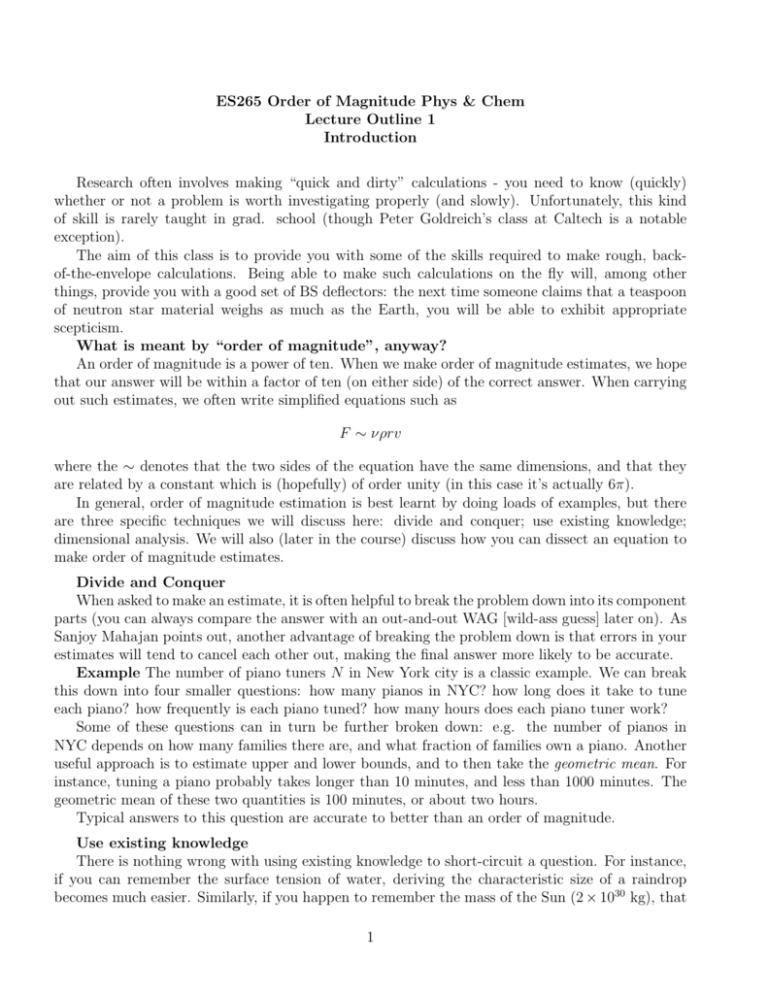
ES265 Order of Magnitude Phys & Chem Lecture Outline 1 Introduction Research often involves making “quick and dirty” calculations - you need to know (quickly) whether or not a problem is worth investigating properly (and slowly). Unfortunately, this kind of skill is rarely taught in grad. school (though Peter Goldreich’s class at Caltech is a notable exception). The aim of this class is to provide you with some of the skills required to make rough, backof-the-envelope calculations. Being able to make such calculations on the fly will, among other things, provide you with a good set of BS deflectors: the next time someone claims that a teaspoon of neutron star material weighs as much as the Earth, you will be able to exhibit appropriate scepticism. What is meant by “order of magnitude”, anyway? An order of magnitude is a power of ten. When we make order of magnitude estimates, we hope that our answer will be within a factor of ten (on either side) of the correct answer. When carrying out such estimates, we often write simplified equations such as F ∼ νρrv where the ∼ denotes that the two sides of the equation have the same dimensions, and that they are related by a constant which is (hopefully) of order unity (in this case it’s actually 6π). In general, order of magnitude estimation is best learnt by doing loads of examples, but there are three specific techniques we will discuss here: divide and conquer; use existing knowledge; dimensional analysis. We will also (later in the course) discuss how you can dissect an equation to make order of magnitude estimates. Divide and Conquer When asked to make an estimate, it is often helpful to break the problem down into its component parts (you can always compare the answer with an out-and-out WAG [wild-ass guess] later on). As Sanjoy Mahajan points out, another advantage of breaking the problem down is that errors in your estimates will tend to cancel each other out, making the final answer more likely to be accurate. Example The number of piano tuners N in New York city is a classic example. We can break this down into four smaller questions: how many pianos in NYC? how long does it take to tune each piano? how frequently is each piano tuned? how many hours does each piano tuner work? Some of these questions can in turn be further broken down: e.g. the number of pianos in NYC depends on how many families there are, and what fraction of families own a piano. Another useful approach is to estimate upper and lower bounds, and to then take the geometric mean. For instance, tuning a piano probably takes longer than 10 minutes, and less than 1000 minutes. The geometric mean of these two quantities is 100 minutes, or about two hours. Typical answers to this question are accurate to better than an order of magnitude. Use existing knowledge There is nothing wrong with using existing knowledge to short-circuit a question. For instance, if you can remember the surface tension of water, deriving the characteristic size of a raindrop becomes much easier. Similarly, if you happen to remember the mass of the Sun (2 × 1030 kg), that 1 saves you having to calculate it from the orbital characteristics of the Earth. The real trick here is to have to memorize as few facts as possible, which requires using them in imaginative ways. Thus, it is not actually necessary to memorize the surface tension of water, as long as you know the typical atomic binding energy (see Lecture 2). On the other hand, it is very annoying to have to derive e.g. Avogadro’s number from first principles. Over the course, we will develop a minimal list of numbers (and equations) which should be committed to memory. Dimensional analysis With the exception of EM, quantities can be expressed in terms of the fundamental dimensions of mass (M ), length (L) and time (T ). Thus, the units of viscosity, written [Pa s], are M L−1 T −1 . At its simplest, dimensional analysis involves making sure that the two sides of an equation are dimensionally correct (you would be amazed at how many published equations do not meet this criterion). A more advanced step is to make use of Buckingham Pi Theorem. This says that if you have n variables and r dimensions (usually 3), then you can form n − r independent dimensionless groups. Dimensionless groups are useful because they don’t care about what kinds of units you are using. Furthermore, if the groups are denoted g1 , g2 , g3 , · · · then the Pi theorem says that: g1 = f (g2 , g3 , · · ·) where f is some undetermined function. This approach sometimes allows you to determine useful physical results directly. For instance, if we consider the drag force F [M LT −2 ] on a body, we would expect it to depend on the viscosity ν [L2 T −1 ], fluid density ρ [M L−3 ], body radius r [L] and velocity v [LT −1 ] (deciding which variables are likely to be important requires physical intuition, or black magic). We have five variables and three dimensions, so we expect 5-3=2 independent dimensionless groups. Deciding how to generate these dimensionless groups requires more black magic, but in this case a good choice is F vr , Π2 = 2 2 Π1 = ν ρr v We therefore obtain the result that vr F = ρr v f ν 2 2 The remaining question is the nature of the function f . In the case of a viscous material, we would expect the drag force to be proportional to viscosity, in which case f (x) must be 1/x, yielding F ∼ νρrv where again the ∼ appears because the expression will contain an undetermined constant (hopefully of order unity). In the case of a very inviscid fluid, the viscosity must not play a role at all, in which case Π1 is irrelevant, so f (x) is a constant and we obtain directly the result that F ∼ ρr2 v 2 which is correct for turbulent drag. 2 Example Derive Kepler’s third law by dimensional analysis Example Use dimensional analysis to derive the radius of a black hole Example Find an expression for the transient diameter of an impact crater into a strengthless material (f (x) is undetermined). 3
